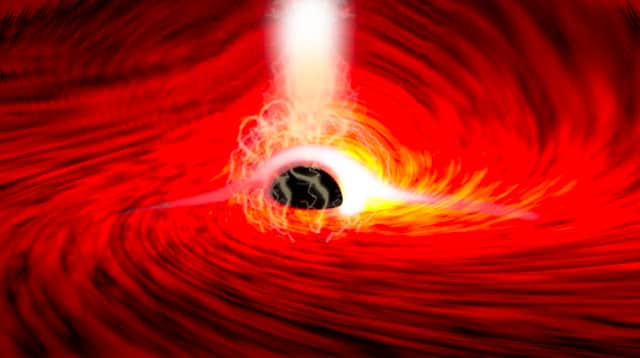Astronomers see light from the other side of a black hole for first time - proving Albert Einstein’s theory right
This article contains affiliate links. We may earn a small commission on items purchased through this article, but that does not affect our editorial judgement.


Bright flares of X-rays were spotted bursting from a supermassive black hole at the centre of a galaxy 800 million light years away, which is relatively normal.
Researchers were studying a feature known as the corona but telescopes also picked up unexpected “luminous echoes”.
At-a-glance: 5 key points
- These additional flashes were smaller, later and of different colours than the bright flares.
- The discovery confirms Albert Einstein’s theory on general relativity.
- Over a century ago, Einstein predicted that the gravitational pull of black holes were so strong that they should bend light right around them.
- This effect has given scientists their first glimpse of what lies behind.
- The warped light was detected as faint flashes of X-rays emitting from a supermassive black hole 800 million light years away.
What did the scientists say?
Advertisement
Hide AdAdvertisement
Hide AdRoger Blandford, a co-author of the research, published in Nature, said: “Fifty years ago, when astrophysicists starting speculating about how the magnetic field might behave close to a black hole, they had no idea that one day we might have the techniques to observe this directly and see Einstein’s general theory of relativity in action.”
Dan Wilkins, an astrophysicist from Stanford University, said: “Any light that goes into that black hole doesn’t come out, so we shouldn’t be able to see anything that’s behind the black hole.
“The reason we can see that is because that black hole is warping space, bending light and twisting magnetic fields around itself.”
Background
General relativity, also known as the general theory of relativity, is the geometric theory of gravitation published by Albert Einstein in 1915 and is the current description of gravitation in modern physics.
Advertisement
Hide AdAdvertisement
Hide AdIn addition to proving Einstein's theory of relativity is right once again, the latest discovery could also help astronomers better understand supermassive black holes.
"Their result provides further support for Albert Einstein's general theory of relativity, which continues to hold up well after more than 100 years since publication," said said Michael Cowley, an astrophysicist at the Queensland University of Technology, who was not involved in the study.
"Observations such as these provide us more insight into the nature of supermassive black holes, along with how they can generate such awesome amounts of power."
A message from the editor:
Thank you for reading. NationalWorld is a new national news brand, produced by a team of journalists, editors, video producers and designers who live and work across the UK. Find out more about who’s who in the team, and our editorial values. We want to start a community among our readers, so please follow us on Facebook, Twitter and Instagram, and keep the conversation going. You can also sign up to our newsletters and get a curated selection of our best reads to your inbox every day.
Comment Guidelines
National World encourages reader discussion on our stories. User feedback, insights and back-and-forth exchanges add a rich layer of context to reporting. Please review our Community Guidelines before commenting.